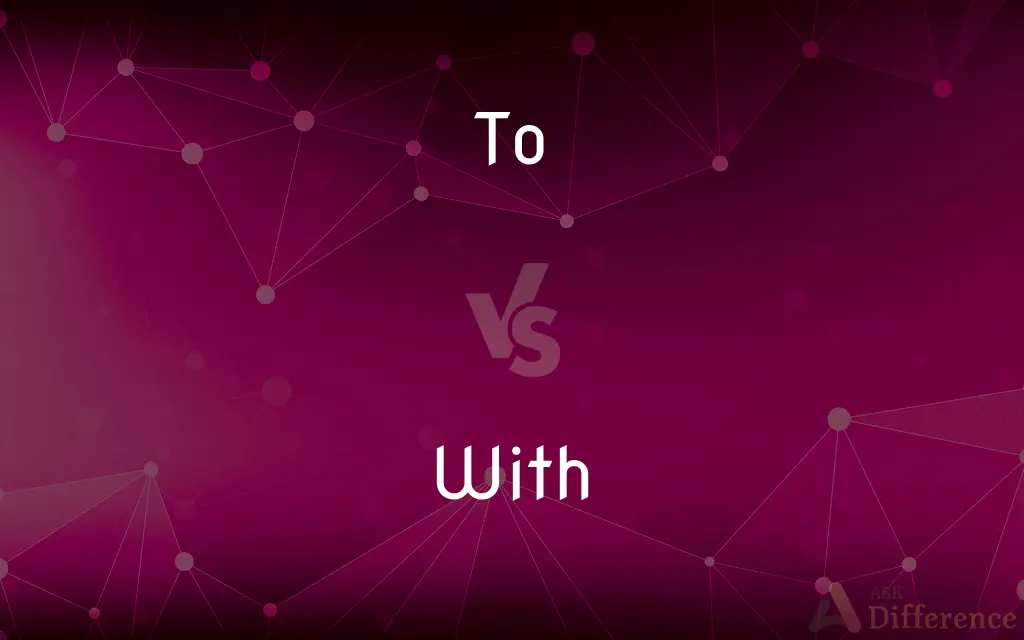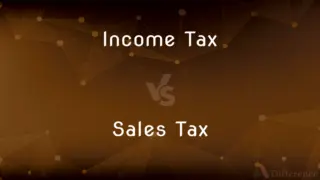To vs. With — What's the Difference?
By Tayyaba Rehman & Maham Liaqat — Published on September 7, 2024
"To" denotes direction, purpose, or recipient, emphasizing movement or intention (e.g., going to the store). "With" signifies accompaniment, manner, or means, highlighting connection or possession (e.g., walking with a friend).

Difference Between To and With
Table of Contents
ADVERTISEMENT
Key Differences
"To" is primarily used to indicate direction towards a place, object, or person. It suggests a movement or an intended destination, as in traveling to a city or writing a letter to a friend. "With," on the other hand, implies a relationship or association between people, things, or ideas. It can denote companionship, as in having lunch with a colleague, or tools used in an action, as in cutting with a knife.
When expressing purpose or intent, "to" is used to describe the reason behind an action. For example, one might learn to drive to gain independence. "With" is used to describe the manner in which something is done or the means by which a goal is achieved, such as solving a problem with creativity.
"To" can also be used in infinitive verb forms to express actions that are to be done, showing potential or future actions, like in the phrase "to read." "With" is used to describe characteristics, conditions, or attributes, such as a person with determination.
In the context of time, "to" can denote a specific point in time, especially in telling time, like quarter to six, indicating a nearing of that time. "With" does not commonly relate to time, but rather to specifying conditions or circumstances at a moment, like dealing with pressure.
"To" is often used in idiomatic expressions to convey various abstract concepts, like "to the best of my ability." "With" is similarly employed in idioms to express relationships or conditions, such as "at peace with oneself."
ADVERTISEMENT
Comparison Chart
Primary Use
Direction, purpose, recipient
Accompaniment, manner, means
Example Context
Going to a place
Doing something with someone
Relation
Movement towards something
Connection or association
Verbal Form
Infinitive form (to read)
Not applicable
Idiomatic Use
To convey abstract concepts
To express relationships, conditions
Compare with Definitions
To
Indicates direction or destination.
She is going to the office.
With
Indicates accompaniment or association.
He came with his friend.
To
Marks the infinitive form of a verb.
To understand is to forgive.
With
Specifies possession or attachment.
A man with a vision.
To
Used in telling time towards the hour.
It's quarter to five.
With
Describes manner or means.
She writes with passion.
To
Expresses purpose or intention.
They moved to the city for better opportunities.
With
Implies condition or circumstance.
They were faced with a challenge.
To
Shows a range or comparison.
From dawn to dusk.
With
Used to indicate the instrument, agent, or cause.
Cut with a knife.
To
In a direction toward so as to reach
Went to the city.
With
In the company of; accompanying
Did you go with her?.
To
Towards
Turned to me.
With
Next to; alongside of
Stood with the rabbi.
Sat with the family.
To
Reaching as far as
The ocean water was clear all the way to the bottom.
With
Having as a possession, attribute, or characteristic
Arrived with bad news.
A man with a moustache.
To
With the resultant condition of
Nursed her back to health.
With
According to the experience or practice of
With me, it is a question of priorities.
To
Used to indicate appropriation or possession
Looked for the top to the jar.
With
(obsolete) To denote the accomplishment of cause, means, instrument, etc; – sometimes equivalent to by.
Slain with robbers
To
Indicating destination: In the direction of, so as to arrive at.
We are walking to the shop.
With
With denotes or expresses some situation or relation of nearness, proximity, association, connection, or the like.
To
Used after an adjective to indicate its application.
Similar to ..., relevant to ..., pertinent to ..., I was nice to him, he was cruel to her, I am used to walking.
With
To denote a close or direct relation of opposition or hostility; - equivalent to against.
Thy servant will . . . fight with this Philistine.
To
The preposition to primarily indicates approach and arrival, motion made in the direction of a place or thing and attaining it, access; and also, motion or tendency without arrival; movement toward; - opposed to from.
Stay with us, go not to Wittenberg.
So to the sylvan lodgeThey came, that like Pomona's arbor smiled.
I'll to him again, . . . He'll tell me all his purpose.She stretched her arms to heaven.
With
To denote association in thought, as for comparison or contrast.
Can blazing carbuncles with her compare.
To
Hence, it indicates motion, course, or tendency toward a time, a state or condition, an aim, or anything capable of being regarded as a limit to a tendency, movement, or action; as, he is going to a trade; he is rising to wealth and honor.
With
To denote having as a possession or an appendage; as, the firmament with its stars; a bride with a large fortune.
To
In many phrases, and in connection with many other words, to has a pregnant meaning, or is used elliptically.
We ready are to try our fortunesTo the last man.
Few of the Esquimaux can count to ten.
Common Curiosities
What does "to" indicate in a sentence?
"To" primarily indicates direction, purpose, or the intended recipient of an action.
What role does "to" play in verb forms?
"To" is used with the infinitive form of verbs to express actions that are to be done.
How does "with" relate to expressing manner or means?
"With" describes the manner in which something is done or the means by which a goal is achieved.
Can "to" and "with" be used interchangeably?
No, they serve different purposes in a sentence and are not interchangeable.
In what context is "to" used for comparisons?
"To" shows a range or comparison, as in "from dawn to dusk."
How is "with" used to describe conditions?
"With" implies certain conditions or circumstances, as in "dealing with pressure."
What is an example of "to" indicating purpose?
An example would be "to learn to drive for independence."
How is "with" commonly used?
"With" signifies accompaniment, manner, or means, highlighting connection or involvement.
Can "with" denote possession?
Yes, "with" can specify possession or attachment, as in "a man with a plan."
Is "to" used in time expressions?
Yes, "to" can indicate a specific point in time, especially when telling time.
How do "to" and "with" differ in indicating relationships?
"To" suggests a directional or purposeful relationship, whereas "with" indicates a more general association or accompaniment.
How does "to" function in idiomatic expressions?
"To" is used in idioms to convey abstract concepts or intentions.
Can "with" describe the manner of action?
Yes, "with" can describe how an action is performed, like "solving with creativity."
Do "to" and "with" have similar functions in a sentence?
No, they have distinct roles, with "to" focusing on direction, purpose, and recipient, and "with" on accompaniment, manner, and means.
What is a common use of "with" in idiomatic language?
"With" is often used in idioms to express relationships or conditions, like "at peace with oneself."
Share Your Discovery

Previous Comparison
Income Tax vs. Sales Tax
Next Comparison
Federalists vs. Anti FederalistsAuthor Spotlight
Written by
Tayyaba RehmanTayyaba Rehman is a distinguished writer, currently serving as a primary contributor to askdifference.com. As a researcher in semantics and etymology, Tayyaba's passion for the complexity of languages and their distinctions has found a perfect home on the platform. Tayyaba delves into the intricacies of language, distinguishing between commonly confused words and phrases, thereby providing clarity for readers worldwide.
Co-written by
Maham Liaqat












































